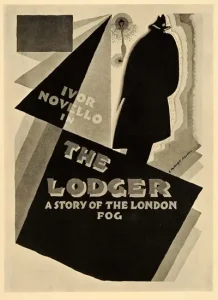Whispers of Suspicion: How Hitchcock's 'The Lodger' (1927) Unveiled the Master of Suspense!
The Lodger: A Story of the London Fog
(UK, 1927, Alfred Hitchcock, 90 minutes)
In the nascent, often chaotic landscape of British silent cinema, a young filmmaker was beginning to hone his craft, displaying an uncanny knack for suspense and visual storytelling that would soon earn him the moniker "Master of Suspense." Alfred Hitchcock, still in his twenties, had already directed a few features, but it was with The Lodger: A Story of the London Fog (1927) that he truly found his distinctive voice and announced his arrival as a major talent. This film isn't merely a classic of silent horror; it's a foundational text in Hitchcock's unparalleled career, showcasing his nascent mastery of tension, his fascination with false accusation, and his ability to manipulate audience perception. It solidified his reputation in Britain and subtly laid the groundwork for the psychological thrillers that would become his hallmark, cementing its place as an enduring, influential cult classic and a crucial piece of cinematic history.
The film plunges us into a city gripped by terror, as a serial killer known as "The Avenger" preys on young, blonde women in London. Into this atmosphere of fear arrives a mysterious new lodger (Ivor Novello) at a boarding house run by Mr. and Mrs. Bunting. He is handsome, aloof, and dresses only in black, immediately arousing suspicion, especially when he begins to exhibit strange behavior and insists on removing portraits of blonde women. The Buntings' daughter, Daisy (June Tripp), a blonde model, initially falls for his brooding charm, much to the dismay of her detective boyfriend, Joe Chandler (Malcolm Keen). Hitchcock expertly crafts a narrative built on mounting paranoia and ambiguity, constantly hinting at the lodger's guilt while simultaneously revealing his vulnerability. The film masterfully uses visual cues, expressionistic lighting, and psychological tension to keep the audience guessing, exploring themes of false accusation, the darkness hidden beneath respectable facades, and the pervasive fear that can grip a city.
Director: Alfred Hitchcock.
Cast: Ivor Novello as The Lodger, Marie Ault as The Landlady (Mrs. Bunting), Arthur Chesney as Her Husband (Mr. Bunting), and June Tripp as Daisy Bunting.
Special Info/Trivia: The Lodger is widely considered Alfred Hitchcock's first truly "Hitchcockian" film, establishing many of his signature themes and techniques. Hitchcock makes his famous cameo appearance in the film, sitting at a desk in a newspaper office, a tradition he would continue throughout his career. The film's protagonist, Ivor Novello, was a very popular star of the era. It was based on Marie Belloc Lowndes' 1913 novel of the same name. The film's ending was famously altered by the studio to preserve Novello's star image, making the lodger innocent, against Hitchcock's initial preference for ambiguity.

